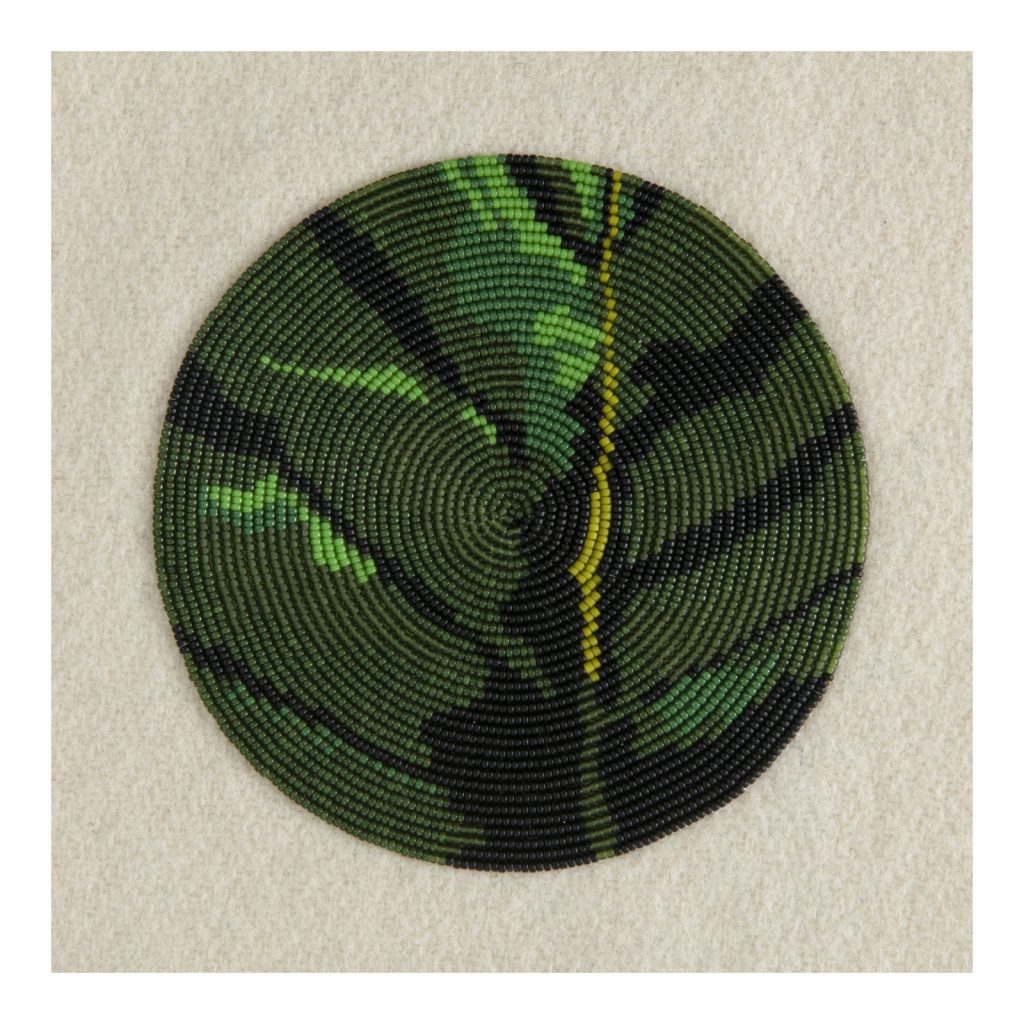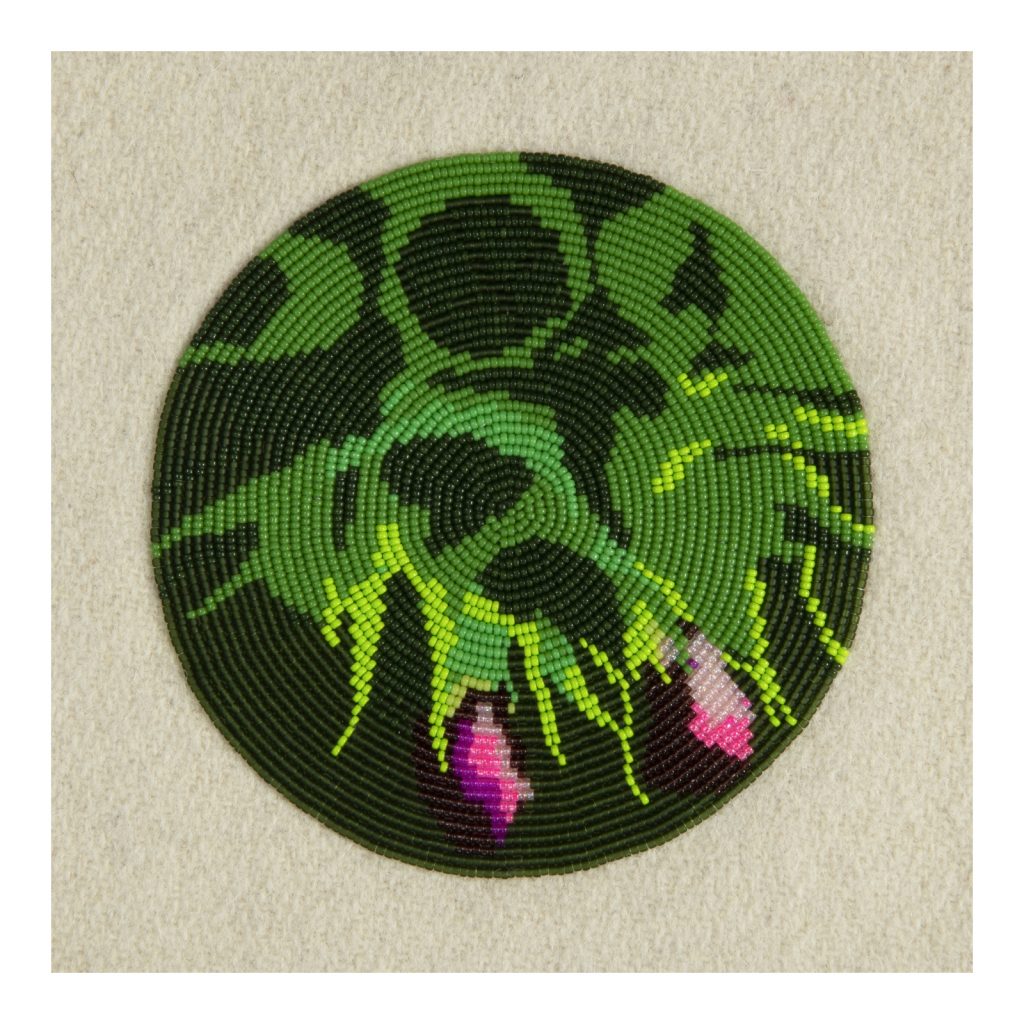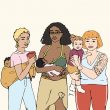By Carrie Allison

First Family, Amelanchier Alnifolia, 2019
Sustenance for our bodies, lands, and spirits are inherently interconnected in Indigenous teachings, language, ceremony, art, and contemporary ways of being. Sustenance is often cyclical and reciprocal; it asks for nothing but trusts that we won’t take too much.
It is through creating that I gain sustenance, through my work as an active community member and through critically engaging with dialogues such as this. I would like to start by situating myself. My name is Carrie Allison Payiw. I grew up on the unceded and unsurrendered lands of the Sḵwx̱ wú7mesh (Squamish), Stó:lō and Səl̓ílwətaʔ/Selilwitulh (Tsleil-Waututh) and xʷməθkʷəy̓əm (Musqueam) Nations. My mother is nêhiýaw/Cree, Métis, and Scottish while my estranged father is of British descent; he was born and currently lives in New Zealand. I identify as nêhiýaw/Cree, Métis, and European descent with relations and ancestral roots in maskotewisipiy (High Prairie, Alberta), Treaty 8. In the last ten years, my work has aimed to connect to my maternal family and ancestors through various mediums, such as artwork, writing, being on the land, being with community, and supporting Indigenous sovereignty. I wear many hats in the art world, as many folks do, but I am predominantly an artist. My practice responds to my maternal nêhiýaw/Cree and Métis ancestry, thinking through intergenerational cultural loss and acts of reclaiming, resilience, resistance, and activism, while also thinking through notions of allyship, kinship and visiting.
My work combines newer technology such as digital media, animation, video, and audio with older technologies like drawing and beadwork to reclaim, remember, recreate, and celebrate my ancestry—an active act of sustenance. My practice is time-intensive, repetitive, durational, and thoughtful. I practice beading to connect with histories, narratives, relatives, and ancestors. It is through this gesture that I find relations and build stronger connections.
I created my series, titled First Family, to spend time with and honour some medicinal plants from my relatives and ancestors’ territory. In my artistic practice, I try to develop projects that will allow me to foster stronger relationships with my nêhiýaw/Métis territory and relations. Although these muted connections to my homelands, culture, and relations are due to colonialism, it is my individual responsibility to nurture them. For this project, I travelled to Northwest Alberta to visit the land and my relatives, building stronger relationships through research and spending time with family and the land. This process is lifelong; it takes commitment and resources to cultivate these relationships. This, to me, is sustenance, centring my own lived experience while actively seeking connection through respectful interactions, with both human and non-human beings.
I also practice relationship-building through my interactions here in Mi’kma’ki, finding ways to support the community, personally and professionally. Through my practice, I seek to honour the land I am visiting, as well as my ancestors. I have been an uninvited guest in Mi’kma’ki since 2010, and my entire art career has been situated here on the East Coast. I am so blessed to have the opportunity to walk this land and gain inspiration from it every day. I would like to thank the Mi’kmaq Nation for hosting me and for caring for this land since time immemorial.
I mention all this to make it clear I am not an Indigenous person from this territory. I do not know these lands and waterways the way Mi’kmaq do, though we share common histories. We share histories of oppression through historical cultural genocide, assimilation by the Canadian government and Christian churches, and displacement and removal from our lands. And we continue to experience cultural and physical genocide through ongoing policy. Because colonial systems have been so successful, most Canadians do not know or understand Indigenous sovereignty and how land is at the heart of all Indigenous (Metis, Inuit, and First Nations) and Canadian tensions. The Mi’kmaq are being denied their rights to fish, hunt, and trade on their own lands, despite The Peace and Friendship Treaties. My ancestors also had those rights taken from them. We were forced into signing a treaty, through starvation, relocation, and reservations. There are no modern treaties (during Canada’s life) with the Indigenous nations here in Mi’kma’ki (Wabanaki Confederacy), as the Wabanaki also had their rights pushed aside for the benefit of Canada, Canadians, and corporations. Despite this, we have survived. Through community, family, ceremony, and love for the land, we have survived.
Our sustenance as Indigenous peoples comes from the land and our deep relationship with it. We make artwork rooted in this relationship, and we cannot separate ourselves from it. Art is a way to heal, to acknowledge, and to tell our stories. It is through murals, dance, song, garments, jewelry, and tattooing practices that we make ourselves seen and claim space, for ourselves, our communities, our families, and our narratives. Indigenous peoples have always prioritized and seen the value in art practices because they are interwoven among our beliefs and tied into our ceremonies.
They are the way we time travel to hold our ancestors tightly. In a panel discussion for Counter Memory Activism’s Cultural Spaces as Living Monuments, Peter Morin of the Tahltan Nation said, when speaking of early bead trade relationships, “We have always prioritized buying artist supplies.”
We, Indigenous peoples, have always seen the value in making for each other, for the land, and to honour the spirits. We have continued to make art, pass on language, ceremony, dance, song, names, and traditions through sheer determination, in spite of colonial assimilation and oppression tactics, laws, and orders. Indigenous peoples have always privileged and thought about future generations and how decisions will affect them.

First Family, Mentha arvensis, 2019
As I sit here writing this article, I am growing a child inside me, as my mother has done, as her mother has done, and on back down the matriarchal line. Sitting here, I can’t help but think about my child’s life in the future as a young nêhiýaw/Cree, Métis, European and Acadian descent person. What will their life look like here on Turtle Island, within these colonial borders of Canada, right here in Mi’kma’ki? Will they grow up feeling the weight of seeing the constant injustice Indigenous peoples are forced to carry? Or will settler words of Nation to Nation living actually be honoured in this country? Will individuals, institutions, and organizations seek to understand what daily anti-colonial practices look like, instead of decolonizing, which, through institutional buy-in, has lost all meaning.
While I’ve been pregnant, Mi’kmaw fishers have been under attack for asserting their inherent and treaty right to fish. Non-Indigenous fishers have been harassing them, physically and verbally threatening them, and attacking Indigenous properties and bodies. The government has failed to uphold the Mi’kmaq rights (which unfortunately is expected). It has been especially disheartening to witness the lack of response from institutions and organizations across Turtle Island, and even more devastating within Mi’kmaq territory. I have sat through countless lectures, artist talks, artist openings, and public discussions, and they have all started with a land acknowledgement. They include a few sentences that acknowledge the territory they are on, and the Peace and Friendship Treaties, and usually finish with the words: We are all treaty people. Yet, now that Indigenous Mi’kmaw fishers are asking for more support, these spaces stay silent. When verbal support matters, institutions and organizations turn their cheek, not wanting to get involved in the politics of the situation. Art is political. Indigenous art is especially political. Our existence is political. When these institutions show our artwork, I can only see that as virtue signaling, an empty gesture meant to appease popular demand and imitate institutional morale.
Institutions, organizations, and governments across Mi’kma’ki need to step up, they need to show their support for Indigenous livelihood through constant, ongoing, and renewed initiatives. We need to see them actively supporting us, actively lifting us up, and actively engaging with us. Let’s be clear: we do not trust you. You say one thing and do another. You say, “we are all treaty people,” and do not stand with treaty rights on the land you commonly acknowledge and occupy. You say you want more Indigenous content in your gallery, exhibition, and biennale while you continue to hire non-Indigenous White settlers who do not have connections to our communities.
What Mi’kma’ki really needs is more commitment to the growth of Indigenous youth and emerging arts workers, as well as Black people and People of Colour. The Atlantic provinces need to build capacity by mentoring, uplifting, and supporting Indigenous people who can tell these spaces that they are letting our communities down, that their words are empty and without action. Trust needs to be at the forefront for institutions, and they need to earn it.
To be clear, it is not enough to hire one Indigenous employee in a sea of white settlers—this is not a sustainable action. The past is littered with shameful behaviour by most institutions, organizations, and governments; the present is filled with empty gestures without action (land acknowledgements and others, such as the Truth and Reconciliation Commission of Canada, the United Nations Declaration on the Rights of Indigenous Peoples, and reports on Missing and Murdered Indigenous Women, Girls and Two Spirit). What are you doing to uplift our sovereignty, our elders, our youth, and our future generations?
We have always lived wholeheartedly, ensuring that our circle is sound and full. Sustenance to us is feeding ourselves and our communities, with future generations in mind. Sustenance is ensuring that our nourishment is ceremonial, spiritual, artistic, and land and body centred. Art has been intrinsic to Indigenous ways of being since time immemorial, and we have always understood the importance of this nourishment. It was never intended to be hoarded by the elite. Our generosity is our wealth, passing on our techniques, ideas, designs, and stories in the face of cultural genocide and assimilation. I have been taught that whatever I am creating exists in a continuum of my ancestors and kin. What I create is because of them, and how I pass that on is of the utmost importance. Why would I share that with you if I do not trust you? Why would I share that with you when your gestures are motionless and inconsequential? This is a call for institutions, organizations, and governments to start building trust through commitment to Indigenous sovereignty and support for future generations.
















Leave a Reply